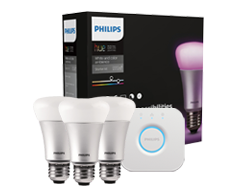
I was recently gifted a Philips Hue starter kit and have spent the past few days setting it up and learning more about it. The Hue is an Internet connected multicolour LED light, which is available in a number of form factors. The starter kit includes 3 bulbs which fit a standard socket, and a controller called the Hue bridge. Additionally, there are a number of controllers, fixtures, bulbs and lamps in the series to fill other needs.
The Hue allows one to create a number of lighting modes which mimic natural (or unnatural) lighting scenarios. It is easy to create sunrise or sunset colours, and even change the intensity of the lighting from the low of a nightlight, to almost fluorescent bright. For those who dislike the alarm clock, it is possible to create a lighting pattern that mimics the sunrise - gently waking you with an ever brightening room.
Setup was straight-forward: download the Hue App to my phone, attach the bridge to my router, place a bulb in a lighting fixture, and link the bridge to the App. The App contains a number of Scenes which serve to highlight the breadth of colour options from the warm tones of a tropical sunset to the cool blues of the arctic aurora. Lighting brightness can be changed within each scene, or the user can choose a dim or bright scene. If the built-in scenes don't provide the colour you want, you can create your own through the app, either by selecting a photo from the Camera Roll / photos app, or by choosing a colour from a colour wheel.
In addition to controlling the lights through the phone App, it is recommended to create an account at my.meethue.com, which will allow limited control of the lights through an internet connection on computer or phone. Once set up, the App is location aware, turning on lights as you arrive home, and dimming them when you leave. Arriving home to a dark house was one of my greatest dislikes when I lived in Northern BC, though I loved the late sunsets of summer. I set a number of lights on timers, which helped, but they of course came on at a set time, no matter when the sun set, or I arrived home. That the Hue can be location aware means the lights can come on as you round the corner coming home.
As individuals create and share Recipes and additional Apps, ever more can be done with the lights. There are recipes for Halloween lighting, lightning bolts, sunrises, sunsets, and many other scenarios for folks to enjoy. This lets folk have ever more fun with lighting, all it takes is the addition of a few more lights to a bridge.
Internet of Things
I'm still coming to grips with new technologies for home automation. The only remotes in our house are related to the TV. In one manner or another, we have become accustomed to remotes for TV over the past 30 years, and are still just arriving at the point where a single remote can manage all the electronics associated with TV viewing. The move to connected lights, thermostats, door locks, etc is going to take a while to mature, and for folks to become comfortable to use.
Pros and Cons
Bulbs seem expensive: white run about C$15, while the colour bulbs are C$50, with fixtures costing up to C$600. This compares with a price of about C$5 for a dim-able white LED bulb.
Bulbs are available in a standard base (E27) size and bayonet base ( GU10), but not a candelabra base (B10). Many of the lamps in our house use a B10 size light. EDIT: B10 bulbs are now available.
Small lights for mood lighting are available starting at a few dollars more than the basic bulb, and give the opportunity to create many lighting scenes in a room, including some that are timed to music or games. There is also a battery operated portable light for those times and locations where a plug is unavailable.
A small number of fixtures are currently available for managed lighting in your home.
For more information visit the Philips Hue website.